For the past few days, walking down Robson street has been a jarring experience. What only weeks ago was a vibrant and bustling street in Vancouver, today is a deserted stretch where fashion and beauty flagships have emptied their locales or boarded up their doors and windows. The iconic commercial strip has become a gallery of graffiti tags with no one to watch. The scene is surreal and the feeling is applicable to many other places in our city and beyond. Yet, just a few meters away, by the waterfronts of Vancouver downtown or at neighbourhood parks, dozens of people walk around in an attempt to keep their mental health.
Perhaps you have felt this as well, while diligently lining up with at least a 6 feet distance from the person in front of you when waiting to enter your local grocery store. Or while talking to the cashier through a thick wall of plexiglass. Perhaps you have woken up once again without an alarm clock and lost track of what day it was. Clapping or banging pots at 7:00 pm to thank all frontline workers has become your new social interaction. You have had more video calls than ever before in your life. Maybe you’ve had this feeling while scrolling down your social media feed and realizing what is happening now was only imaginable to a science fiction writer or a virologist, which by the way is a profession you hardly ever heard of before.
You may have heard this word more than ever from your friends, family, colleagues and media – surreal. Alongside these COVID-19 images, that are now etched in your memory, you probably also think of dreamlike scenes and strange artworks you’ve seen first hand or on a device.
Only a little over a month ago we were giving an art talk at Monica Reyes Gallery anchored on Christina Kenton’s work to discuss Surrealism, a modern art movement that stemmed from a world that was very much like ours today—a world of unimaginable realities. The very act of doing that talk felt surreal as we felt the imminent wave of the pandemic approaching Vancouver.
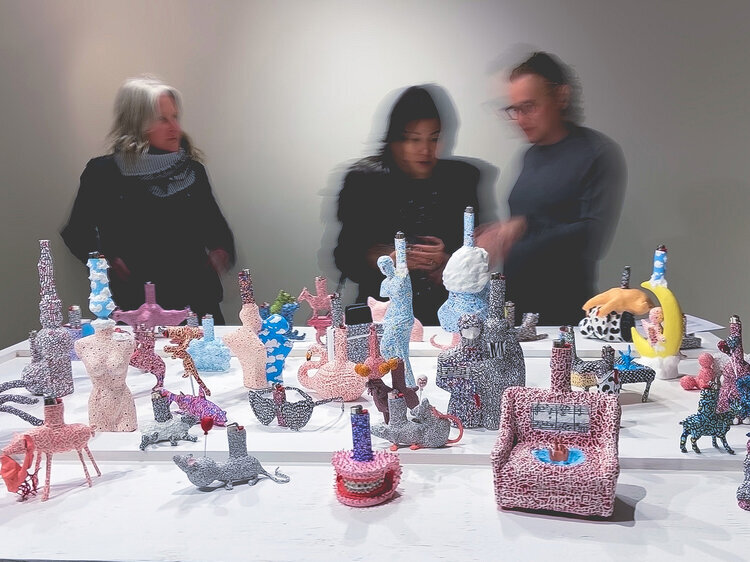
In an attempt to transport you to the day, when our schools were still running, when people were not hoarding toilet paper, when we could still physically gather with friends and hosts dinners; we would like to share the content of that talk where we summarized the Surrealist movement that originated in Paris in the early 20th century, mentioned where the movement influenced Canadian art and talked about its presence in Vancouver.
lighter, strange, clouds, childish, scary, naïve, uncanny, cotton candy, dream-like, colourful, light, playful…
These were some of the words said by our public when we asked them to participate in an adaptation of a cadavre exquis by verbalizing the first word that came to their mind while gathering around Christina Kenton’s work.
According to Surrealist thought, what is listed above is a verbal manifestation of the collective unconscious of our audience that day (with the exception that their responses were influenced with what they were seeing).
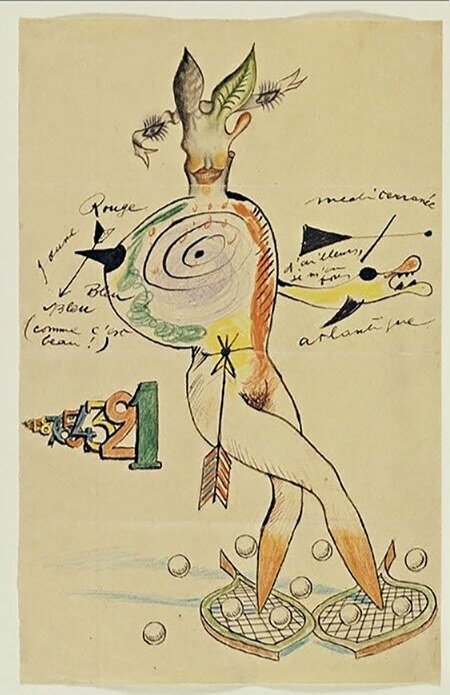
The original format of this Surrealist game is a written or drawn collective creation. Players write in turn on a sheet of paper, fold to conceal what they have written, and pass it on to the next person. The cadavre exquis is an exercise that means to liberate a person from any constraints and show the true personality of a group. The result was considered a mental contagion by Max Ernst.
Si vous aimez l’amour, vous aimerez le Surréalisme
’If you love love, you will love Surrealism’, declared the Surrealist manifesto published in Paris almost one hundred years ago in 1924. In that document founder Andre Breton, defined a new movement that would leave a tremendous international legacy behind and an ethos that is very much alive today.
As we can attest nowadays, people use the word surreal to describe things that are crazy or too strange to be real but in the early 20th century Surrealism was placing a major interest in dreams, fantasies and unconscious thoughts to unearth the “superior reality” of the subconscious. This information was meant to serve as an intellectual weapon in a revolution against a society ruled until then by rational thought.
The prefix ´sur´ comes from french. It means on, above. Being on top of reality or above reality implies a search beyond what we consider to be true. This search was previously sought by the Symbolists but unlike them, the Surrealists had a scientific approach. They had methods, techniques, instructions and recordings of their results. They even founded the Bureau of Surrealist Research where writers and artists gathered information to reveal the unconscious activity of the mind.
Let’s remember that this is a movement that formed between WW1 and WW2. To understand this reaction in art we need to acknowledge that the world around the Surrealists in the early 1900s was originally a world of reason. Reason that ultimately led to the absurdity of war, death and unimaginable atrocities. Before André Breton became the founder of Surrealism his medical studies got interrupted as he was called to be a stretcher bearer at the front during WW1. This first hand experience awakened his interest in psychiatric diseases such as hysteria and psychosis, sources that later served as a source of inspiration for his surrealist writings and thoughts. As a consequence, he saw Art as an anti-war protest.
We can divide Surrealism into two main types; veristic art and automatism art.
Have you heard of Dali? His work fits in the first category, dream inspired art or veristic Surrealism. Salvador Dali, was known for his eccentric behavior and uncanny art which would combine elements that you normally would not see together.

Veristic Surrealists were deeply interested in interpreting dreams as channels for unknown feelings and desires. Their artworks did not begin with a preconceived result. Instead, dreams and subconscious associations between images, text and their meanings became a direct source for their artwork. Artists like Salvador Dali, Max Ernst, Rene Magritte, Dorothea Tanning allowed the images of their subconscious to be undisturbed so that meaning could be understood through analysis. They linked images between the abstract spiritual realities and the real forms of the world. For them, their paintings were a metaphor to an inner reality.
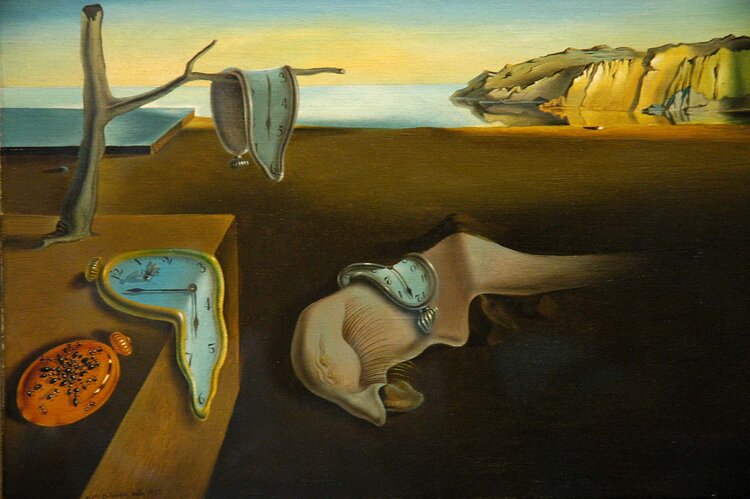
In Dali’s work we can see an example of imagery that seems both real and yet otherworldly. Dali would have been influenced by contemporary thinking such as Einstein’s theory of relativity and Freud’s psychoanalysis. Veristic surrealists tracked images of the subconscious until their consciousness could understand the meaning. For them, the true expression of the subconscious was an image that the consciousness had to break down and translate into a language of its own.
Art has always been the raft onto which we climb to save our sanity, I don’t see a different purpose for it now
Dorothea Tanning
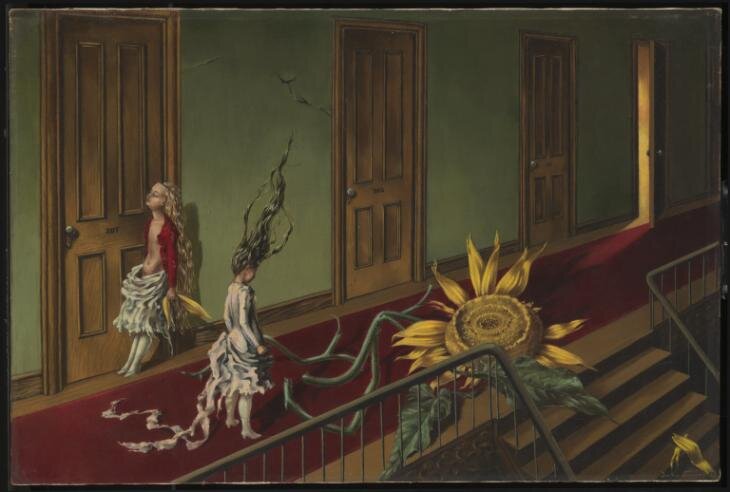
As in many other surrealist paintings, in Eine Kleine Nachtmusik the naturalistic portrayal of people and objects which look familiar but are represented in a nonsensical context, result in both an odd and playful image.
Have you found yourself doodling nonsense while speaking on the phone? That act of making art without thinking is called Automatism. In psychology, ‘automatism’ refers to involuntary actions and processes that are not under the control of the conscious mind–dreaming, breathing, blinking. Automatism played a very important role for Surrealist techniques. Spontaneous (automatic) writing, painting, and drawing; free association of images and words; and collaborative creation though games like the Exquisite Corpse meant to suppress the conscious mind to liberate the subconscious without any further need to investigate meaning.
Do any of these automatist artworks look like one of your doodles?
In the artworks of Joan Miro we can see an unguided hand being let loose on the surface of the canvas. This is a process that would later influence abstract impressionism.
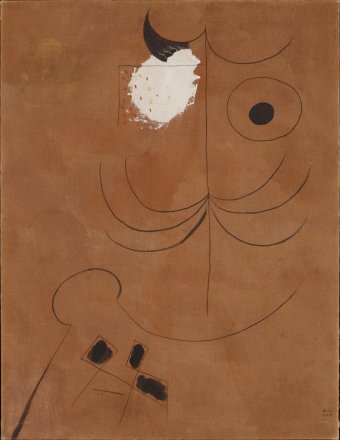
Surrealism had an enormous reach, influencing thought and art in different countries across the globe. Canada was not the exception. There are two main ways in how the Surrealist ethos was influenced by Canadian culture and influenced art in Canada. At first instance a few Surrealists travelled through Canada and took inspiration back to their homebase. Secondly there were three main Surrealist waves in Canada during the 20th and early 21st century.
In a letter to his dear friend André Breton, Wolfgang Paalen expressed his longings for experiencing the breathtaking landscapes of Cascadia and learning about First Nations Art. ‘I believe I am attaining a new perspective on this art –– an art certainly greater than all the assumptions that are made about it in Europe … The feeling of being on a long march through hidden depths … allowed us to observe with great precision the final ray of light cast by a culture of alien luminosity within a Nature of impenetrable wildness’ This letter was written towards the end of a two-month trip Wolfgang Paalen, his wife Alice Rahon and their friend Eva Sulzer did across Alaska, Haida Gwaii, Central B.C. Coast and Vancouver Island in the summer of 1939. The trio traveled by train and boat, trying to learn all they could about Indigenous cultures and coastal towns. The interest in these cultures stemmed from a deep search of the re-enchantment of the world, from an effort to overthrow reason and the moral corruptions that modern artists attributed to their western European civilization.
The spiritual and ancestral connections that the trio attained in this trip would forever influence their surrealist explorations wherever they went. Alice Rahon would later become one of Mexico’s most notable surrealist icons. In 2009 the Museum of Modern Art in Mexico city along with curator Tere Arcq, presented a retrospective of the French/Mexican poet and artist Alice Rahon. The exhibition mentioned the impact that the Pacific Northwest culture and its relationship to the landscape had on the work of Alice Rahon and Wolfgang Paalen. Seeing images of Paalen and Rahon in front of a longhouse was a pleasant discovery and a reaffirmation of the importance of Pacific Northwest culture on Surrealism.
A few years after we would learn more about this exchange of ideas in 2011 when the Vancouver Art Gallery presented a groundbreaking exhibition called ‘The Colour of my Dreams’. It explored in depth and for the first time in an exhibition, the Surrealists´ intense interest in indigenous art of the Pacific Northwest. In the exhibition catalogue, we find more details of how Paalen, Rahon and Sulzer underwent two months of intensive travels which impacted them greatly. They documented their thoughts and experiences in writings, sketches, drawings, photographs (over 300 of them) and notably in 8mm film rolls. Andreas Neufert notes that for ‘Paalen this journey was above all a voyage into the inner world of his images and his childhood’.
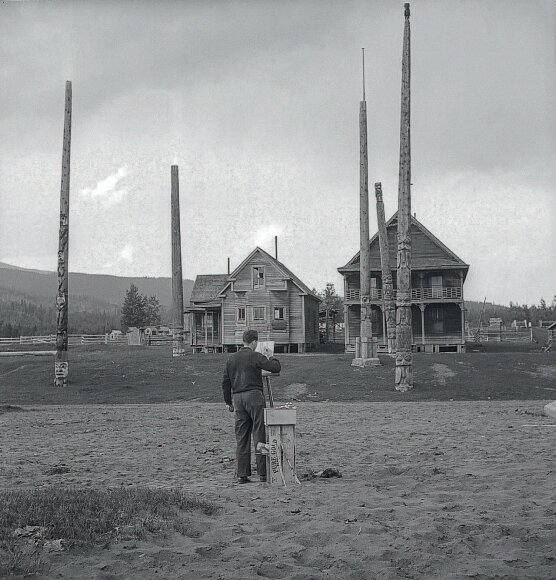
In 1944 the founder of Surrealism, André Breton spent a summer in the Gaspé Peninsula, Quebec to write Arcanum 17. He was particularly taken aback by the impermanence of Percé Rock–a majestic sheer rock formation in the Gulf of Saint Lawrence that crumbles down in slow motion as the water erodes the limestone that it is made of. Breton saw this geological icon as a physical manifestation of hope during the dark times of World War II and became a powerful symbol of the constant changes he observed in nature.
In 1938, The Canadian National Exhibition of Toronto hosted Surrealist Art, an exhibition that formally introduced Surrealism to Canada with works by European surrealists such as Salvador Dali, Rene Magritte, Max Ernst, Ronald Penrose, Grace Pailthorpe and Reuben Mednikoff.
However, it was not until the forming of the Automatistes group in the 1940s that the ground was really set for the continuation of Surrealist thought in Canada. The group of Quebecois artists led by painter Paul-Emile Borduas, defended surrealist values and above all exalted its spontaneous automatic technique as a means of favorising an intuitive, experimental and non-representational approach to art.
During the same decade, the British Surrealist and Psychology Doctor Grace Pailthorpe along with her husband Reuben Mednikoff spent some time in Vancouver where they showed the landscape artist Jock MacDonald how to awaken and release his inner consciousness through teachings of surrealist philosophy and automatic techniques. If Surrealism had scientific ambassadors they would have been Dr. Pailthorpe and Mednikoff who were highly invested in employing the Surrealist ethos as a vehicle for healing individuals and the whole ‘machinery’ of civilization.
It was in the middle of the 1960s however, that a West Coast Surrealist group began to emerge in Vancouver; Gary Lee Nova, Al Neil, Gregg Simpson and Bill Bisset began their experiments with collage. The 60s were a time of change in society. People became interested in all kinds of questions, this triggered the interest of global artists in the west coast. The metaphysical and the Landscape kept on coming back as pillars of investigation. In the 70s The Move gallery in Vancouver became the home of the newly created West Coast Surrealist group. In 1973 the exhibition Canadian West Coast Hermetics was presented at The University of British Columbia and travelled to London, Paris and Belgium. Six years later Natalie Luckyj toured Other Realities; The Legacy of Surrealism in Canadian Art in Paris and London.
After Several Surrealists exhibitions organized by Gregg Simpson, the West Coast Surrealist group was officially formed in 1977. At this time Ladislav Guderna and his son Martin Guderna joined the movement. The Guderna family has helped establish a valuable cultural legacy in Vancouver continuing their dedication to art generation after generation. Not only did Ladislav Guderna leave a rich surrealist body of work after his passing in 1999 but he also instilled a life dedicated to art in his son Martin Guderna and granddaughter Christina Kenton.